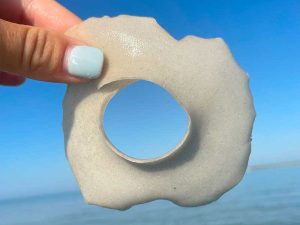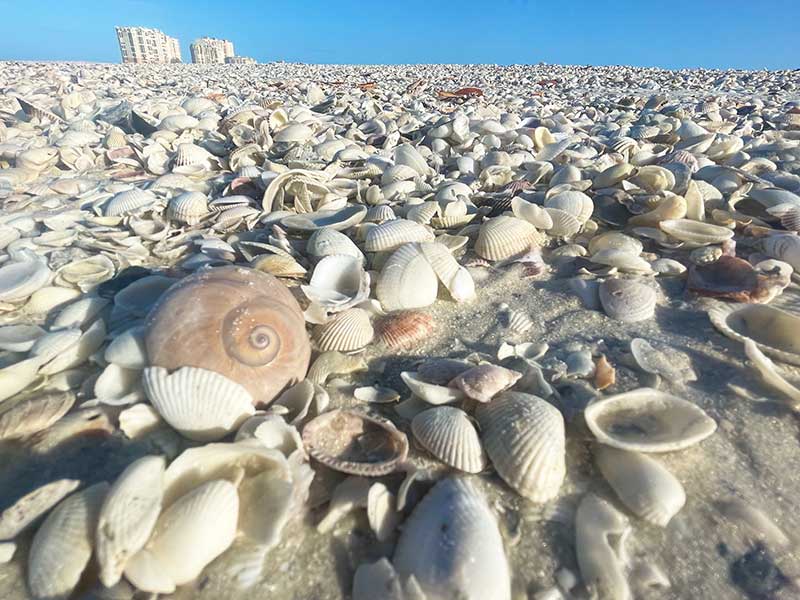Have you ever found a shell with a perfectly round hole drilled in it? It was probably the victim of a Moon Snail. Moon Snails are carnivorous predatory snails that drill distinct bevel-edged bore holes into the shells of prey before consuming the contents. These holes can often be found on small bivalves like clams.
Moon Snails are a group of shells named for the half-moon shaped aperture (or opening) that they feature. These shells spiral clockwise, or to the right, and when the animal is living it possesses a large foot that is used for digging and locomotion. The most commonly found Moon Snail shell in Florida is the Shark Eye.

Florida has the unique benefit of receiving shells on multiple sides, from multiple bodies of water. The Gulf of Mexico provides smaller Moon Snails than the Atlantic side. The average size of Shark Eyes found on the west side of the state average about the size of a gum ball as opposed to their Atlantic counterparts which are normally the size of a a baseball. This size difference could be due to the variance in food source, water temperature and depth variation of the two habitats.
In the spring, sand collar egg casings can be found along the beaches indicating the Moon Snail breeding season. These are created with mucus from the mother snail mixed with sand from the surrounding area. The sand collar is created around the mother snail’s shell and left in the sand on the ocean floor until the eggs are ready to hatch. After hatching, the mollusks begin their life on the ocean floor hunting for food and the sand collar is left to dissolve.
Shark Eyes
The most common Moon Snail in Southwest Florida is called the Shark Eye. Shark Eyes are a grey-pink color, and their round shape resembles an eyeball. These may occasionally be seen with a blue “eye” at the center of the spiral in which case it’s referred to by shellers as a “Paul Newman” after the famous actor’s iconic blue eyes.
When seen alive, the snail has a large beige foot and brown, soft operculum which covers the aperture when the mollusk takes shelter inside its shell.
Colorful Moon Snails/Gaudy Nauticas
The similar yet more desirable Colorful Moon Snail, known locally as the “Gaudy Nautica”, can be also be found in the Southwest Florida area.
These feature the same basic shape of the Shark Eye but feature a dazzling golden and brown zig zag pattern along their white shell.
When seen alive they possess a large beige foot with red pin stripes across it. When the animal moves and stretches its foot, the stripes expand and contract. The operculum of a Colorful Moon Snail is unlike the others in that it is made of solid shell material and is white in color with etched ridges along it’s half-moon silhouette.
White Baby Ear
Even more rare to find among the Moon Snails is the elusive White Baby Ear. These small and delicate shells are a prize for any sheller in the south end of Florida. Finding one of these is quite an achievement due to their camouflaging plain color and their unusually small size.
Their oval shape and elegant curve makes this shell oddly resemble one’s ear. The average size found in the Ten Thousand Islands is that of a pinched penny.
When the animal is alive, the large foot of this mollusk does not actually fit inside the shell but rather engulfs the small shell almost completely, exposing the fleshy body.
All of these stunning shells can be found on the shores of the Ten Thousand Islands. Let your shell guide know if you’re seeking these treasures specifically and we will get you to the hotspots to search for them!
– By “Sarah with an H” Rosenbaum, Captain, Shell Guide & Florida Master Naturalist
